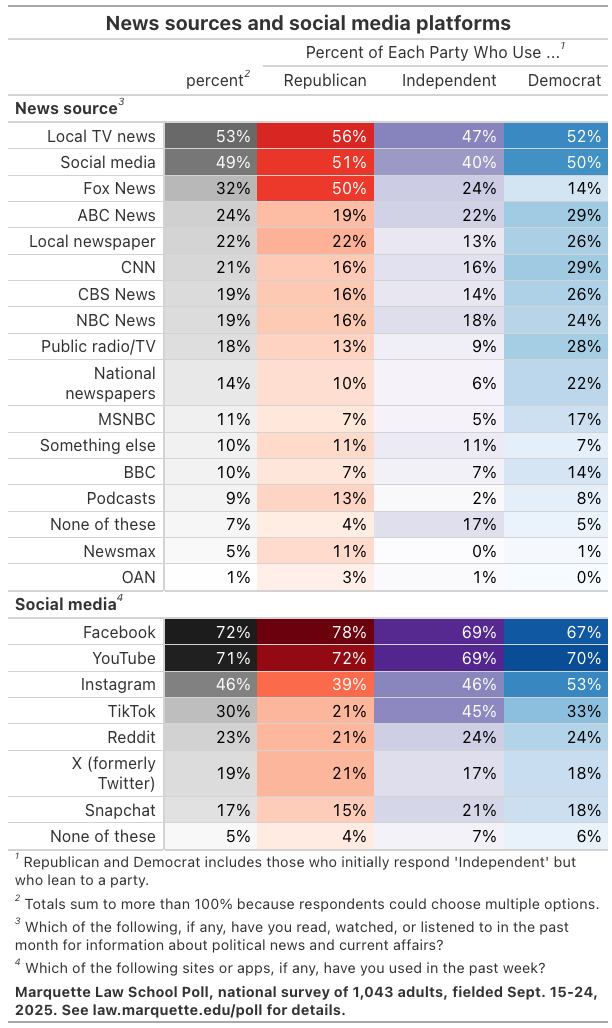How News Sources and Social Media Usage Vary by Party
In our latest poll, we asked respondents to tell us how they learn about the news and which social media platforms they use. Those results are shown in the table below for the entire sample, as well as broken down by party ID.
Here are a few highlights:
- Local TV news is still king. Just over half of adults watch it. The local TV audience leans just slightly Republican, but is overall politically mixed.
- About half of adults get news from social media, evenly-balanced between Democrats and Republicans.
- Fox News is the largest single network, by far. Just about one third of adults reported watching it, including half of Republicans, 24% of independents, and 14% of Democrats.
- The traditional Big Three networks (ABC, CBS, and NBC) and CNN all draw similar audience shares, 19% to 24% of adults. All of their audiences skew left, drawing 24% to 29% of Democrats versus 16% to 22% of Republicans.
- Local newspapers drew 22% of adults, including 22% of Republicans, 13% of independents, and 26% of Democrats.
- While local newspapers show only a small partisan gap in readership, Democrats are far more likely to read a national newspaper, listen to NPR, or watch PBS. Among Democrats, 28% used public radio/TV and 22% read a national newspaper. Among Republicans, 13% used public radio/TV and 10% read a national newspaper.
- MSNBC draws only 11% of adults, including 17% of Democrats and 7% of Republicans.
- Only 9% of adults said they got news from a podcast, but news podcasts were more popular with Republicans (13%) than Democrats (8%). Scarcely any Independents (2%) listened to a news podcast.
- The two far-right competitors to Fox News, Newsmax and OAN, drew 11% and 3% of Republicans, respectively (compared to 50% for Fox).

- The use of social media networks is far less politically polarized than news sources.
- Nothing comes close to Facebook and Youtube in terms of social media usage. Over 70% of adults reported using them in the last week.
- Facebook is a bit more popular with Republicans (78%) than Democrats (67%), but there is no significant partisan gap among Youtube users.
- Instagram and TikTok are both more popular with Democrats and independents than Republicans. TikTok, in particular, draws strongly from independents.
- Reddit and X (Twitter) are more evenly split between partisans. Reddit draws 3 percentage points more of Democrats than Republicans and X draws the reverse.
Elsewhere in the poll, we invited each respondent to write whatever they wanted in response to these three questions.
- What do you like about Donald Trump?
- What do you dislike about Donald Trump?
- What is your biggest concern about the country these days?
You can read the answers verbatim (in randomized order), along with each respondent’s news sources, social media habits, and basic demographic data using this web tool. The tool also allows you to filter for certain news or social media choices. For example, here’s a screenshot showing respondents who get their news from podcasts.

